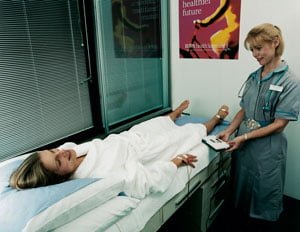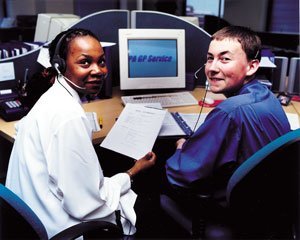
Customer satisfaction depends upon a product’s performance in relation to a buyer’s expectations. If the product’s performance falls short of expectations, the customer will be dissatisfied. However, if the performance matches or exceeds expectations, the customer will be delighted. For companies with a broad customer base, customer satisfaction is both a goal and a major factor in influencing company performance. This case study focuses on BUPA, the independent health and care company and market leader in the health care industry. It illustrates how BUPA uses call centres to help provide customer value and satisfaction which helps it to maintain its market position.
Established in 1947, BUPA has been the UK’s leading health care company for more than 50 years. Although it is a very large organisation, BUPA is not a limited company. It is a provident association, which was originally formed to support its members and it continues to do so today. It has no shareholders and reinvests any surplus into providing better health and care services for its customers.
One way of describing an organisation’s purpose is through its vision. A vision outlines a company’s objectives, i.e. what it represents and sets out to achieve. BUPA was founded to:
- prevent, relieve and cure sickness and ill-health
- promote health in every way
- raise, establish, maintain and administer a fund for defraying medical costs on behalf of its contributors.
BUPA has a range of services designed to promote good health and guard against illness. Medical insurance is a contract between a person or organisation and an insurer. The insurer pays bills when members require private medical care.
In the UK, BUPA is the largest private medical insurer. It has a market share of over 40% and provides cover for approximately 2.3 million people. A comprehensive range of medical insurance schemes exists for both individuals and businesses.
Customer satisfaction

One of the key competitive advantages BUPA has over its rivals in the health care industry is that of high levels of customer satisfaction. In order to maintain this advantage, a major initiative called Experience ’97 was set up three years ago to review the way in which the business operated. It looked at:
- what services were sold
- how they were distributed
- how providers of health care were managed
- how BUPA operated its internal processes.
Driven by the desire to address these four issues, 25 projects were established as part of Experience ’97. The key delivery mechanism for many of these projects was through improving customer service with the establishment of a new and different customer service centre from the ones that had existed previously. The new centre was concerned with more than updating existing systems. Its activities were to include:
- new processes, removing the need for the customer to be involved in any administration new computer systems
- new staff training
- a new working environment.
Research shows that customers value and trust companies which consistently deliver a coordinated set of products or services to meet their individual needs. They also want problems to be solved quickly. This emphasises the key role of the customer service centre in providing customer satisfaction. High quality service enables BUPA to create superior customer value and satisfaction on the basis of trust and confidence.
The role of the customer service centre

BUPA customer service centres provide a direct link which enables BUPA to create and maintain strong relationships with its customers. When people phone BUPA’s service centres, they are very likely to be feeling anxious or seeking advice and reassurance. Many callers are unwell and feeling vulnerable. They may also want help and support on critical medical issues which need to be dealt with quickly and sensitively by BUPA people who understand the nature and gravity of issues they may be facing, as well as the worries they may have.
People in the centre need to be able to answer calls quickly, confirm cover for treatment, reassure customers that BUPA will pay bills and reduce the need for further calls. The process had to be designed to remove any distress from customers so that BUPA can deliver a seamless service that exceeds customer expectations.
Communication with customers takes place over the telephone or by post, though in the future, it could be undertaken by using other communication media such as e-mail. The role of the people working within the customer service centres is to make communication with customers easy, reassuring and valuable. They are encouraged to focus upon building and developing relationships with customers.
BUPA realised that it was necessary to create a modern physical work environment that would involve:
- team work
- staff who have many different skills and roles
- state-of-the-art technology.
The importance of people

The relationship between BUPA and its people is set out in its People’s Charter. A charter is the way in which a company sets out its commitment to its employees, as well as what it expects in return.
The involvement of people in BUPA’s electronic working environment is crucially important in exceeding the expectations of its customers. BUPA centres are different from those in other industries. Callers may be ill or anxious about their own welfare or that of family members who are about to go into hospital. Special personal qualities are required to deal with these calls and it is important that every detail within the call is understood, which may require significant time and patience.
For the people working within the customer service centre this type of work can be draining and stressful. To meet these difficult needs, BUPA has to recruit, train and retain the best people.
Recruitment
The purpose of recruitment is to buy-in and keep the best people to work for the organisation. BUPA matches all job applications to a clear person specification. This describes the requirements of the job holder. The assessment process of prospective employees is built around the personal and functional abilities staff are required to have to deliver excellent service for customers. As people in call centres spend a lot of time on the telephone, a screening interview is carried out on the telephone.
The next stage in the recruitment process is for line managers to run an assessment centre which involves a competency-based interview and a letter writing exercise. Before accepting a position with BUPA, successful candidates are asked to visit a call centre and sit with other BUPA people while they deal with live calls. They also talk to existing BUPA people and have an insight into the working environment.
Training
BUPA invests heavily in staff training. Training develops the skills and knowledge of employees so that they are properly equipped to undertake their work role and take on more demanding jobs in the future. BUPA’s training is both technical and behavioural.

Technical training enables people to support the major computer system changes to deliver services for customers. Behavioural training helps to empower people to meet and exceed customer requirements. Business objectives are used to determine priorities for each individual employee, with specific activities to reflect these priorities. Each individual has a job description which clarifies their role within BUPA. This is a written statement setting out how an employee fits into an organisation and what is expected of them in their role.
Retention
Within BUPA a variety of appraisal and motivational techniques are used. Appraisal helps to identify the strengths and weaknesses of each individual’s performance. It also enables people to give feedback upwards from individual line managers to the board of directors. Action plans are also agreed to ensure that any issues raised can be resolved. People are encouraged to become involved in a participation scheme, which enables them to share in the financial success of the organisation.
Regular briefings, staff newspapers, videos and information bulletins also help to keep them informed of developments and new initiatives within the organisation. The workplace BUPA has established customer call centres in Staines and Manchester. It has developed a working environment in which people feel both motivated and empowered. Other companies’ call centres around the country were visited and specialists were consulted to determine how best to provide customer and people satisfaction.
Measuring performance

Benchmarking is a process through which an organisation can identify best practice. For example, in a call centre this would involve identifying best-in-class practice not just within the health care industry, but in any other industry using call centres. It then becomes a valuable measure of organisational competence.
BUPA undertakes regular market research using customer focus groups, which consists of small numbers of customers who evaluate the products and services it provides. BUPA also uses qualitative and quantitative research. Such research helps to highlight customer satisfaction with the call centres, so that areas of importance are identified and their delivery is monitored.
Conclusion

BUPA’s expertise in call centres has enabled it to establish a 24-hour free health advisory service delivered by a team of qualified nurses. The service provides personal, informed guidance and support to customers, available any time they need it. This represents a different type of service provision by BUPA based upon three core skills:
- a full understanding of customer health requirements before and during primary care
- an ability to influence behaviour
- an ability to become a knowledge organisation, which obtains meaningful data and translates it into added value services for customers.
This case study has shown how the use of call centres manned by capable employees has helped BUPA to improve its service in an industry where service is a critical factor in determining customer satisfaction and competitive advantage. The company recently won the European Customer Call Centre of the Year Award, which emphasises that BUPA can and does give the best possible service for its customers.
